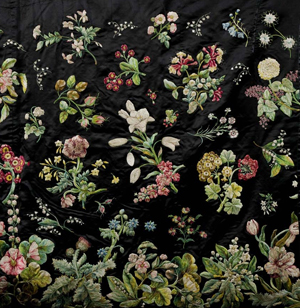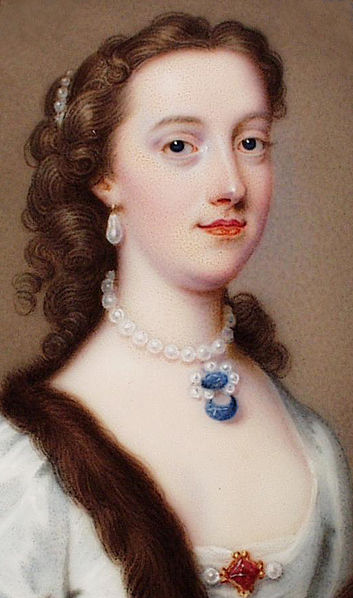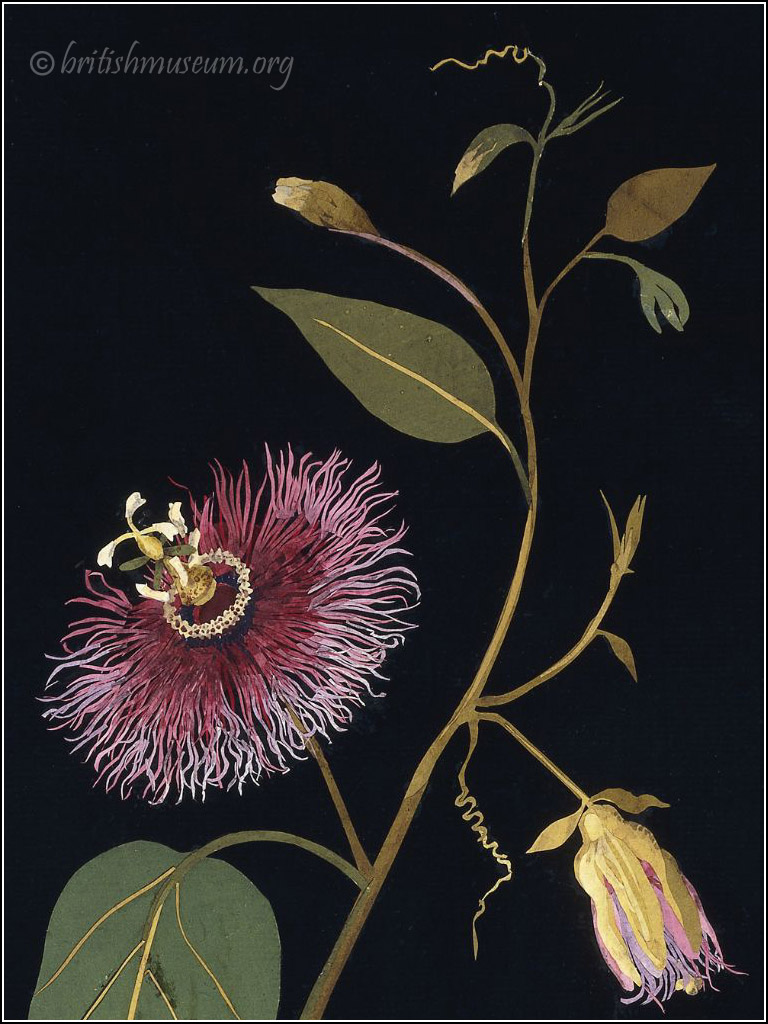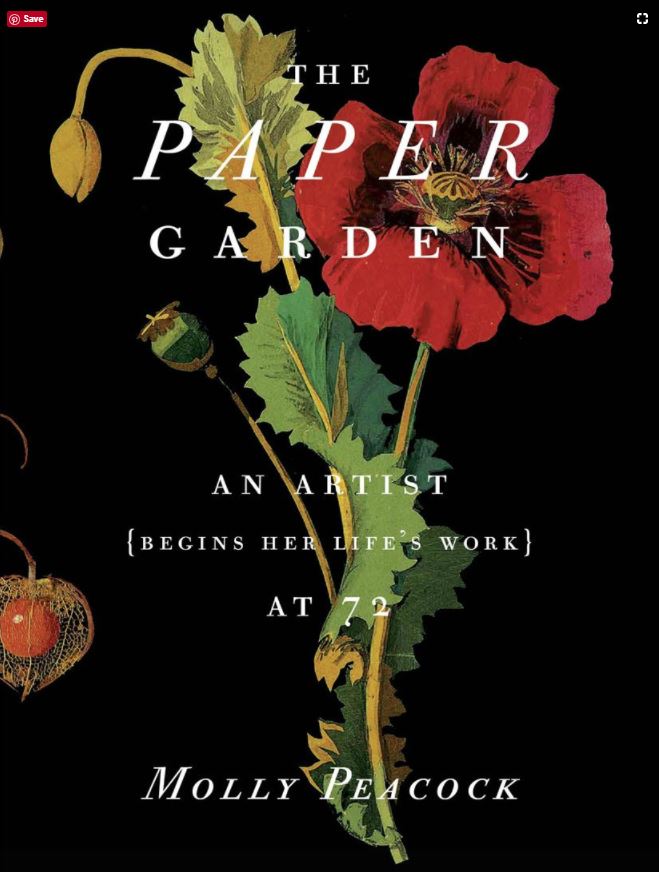An ingenious mind is never too old to learn.
~Mary Granville Delany
The pancratium maritimum, or sea daffodil, grows on beaches along the Mediterranean. That’s an image of it above.
Examine the stamen antennae, fluid white petals, deep blue shadow on the rear leaf. How was it created? Oil, pastel, watercolor? And when? Is it a modern interpretation?
It’s a collage sliced from colored paper. Each stamen, shadow, and gradation represents a separate layer. A woman nearing age 80 made it. It’s dated 1778, not long after her patron King George III lost thirteen troublesome colonies.
Like Grandma Moses, Mary Granville Delany (1700-1788) bloomed in her 70s, when she embarked on her life’s work—creating 985 life-size botanical masterpieces now held by the British Museum.
Some consider her the first mixed media collage artist because she employed paint, paper, and flower parts. Nothing like it had been seen before.
And nothing like it has been seen since.
The Persephone Years
Mary was born in 1700 to Bernard Granville, the third son of a family who backed the wrong claimant in England’s skirmishes of succession. In 1701, Parliament declared a Catholic could not be a monarch, yet the Granvilles supported James Stuart, the Scottish Catholic nearest the throne.

Parliament, however, plucked Georg Ludwig of Hanover, about fiftieth in line but a Protestant, to rule as George I of England.
So instead of a Jane Austen-style fairy tale wedding, Mary got thrown into a Gothic novel. At age 17, she found herself wed (against her will, not that it mattered then), to Alexander Pendarves, a drooling drunk 45 years her senior with a decrepit castle in Cornwall.
She called her new home “Averno,” after the Roman lake thought to be Hades’ entrance. Later she wrote,
…when I was led to the altar, I wished from my soul, I had been led, as Iphigenia was, to be sacrificed. I was sacrificed.
(King Agamemnon sacrificed his daughter Iphigenia so the gods would release the winds and carry him to Troy.)
Seven dark years passed, punctuated by long nights when Mary read to her husband in the frozen cavern of his bedchamber because he couldn’t bear heat during his gout attacks. “I have read three hours together to him, trembling all the time.”
And then one morning, she found him at her side, “quite black in the face. At first I thought him in a fit, but immediately it struck me he was dead.”
Twenty Years of Spring
Mary was 23 years old. But her husband had neglected to change his will so his niece inherited the estate. Mary got a small widow’s stipend.
It was enough. A high-born, low-income widow in 18th c. England became a perpetual house guest and Mary was much sought after. She’d been trained as a lady-in-waiting before her family’s downfall. She could draw, do needlework, speak French, play harpsichord (and had taken lessons from Handel).

Her dress ideas were so unique that, in her 20s, she essentially earned her keep as a fashion designer. She created the piece at left, a black satin overskirt with embroidered wildflowers, which echoes her later collages.
She received several marriage proposals—one (confirmed) from Lord Baltimore, dubbed “The American Prince” since he inherited Maryland’s governorship at age 15 and one (unconfirmed) from John Wesley, future founder of Methodism.
But Mary clung to her small pension and her independence, a testament to the nightmare her marriage had been. At age 33, she traveled to Dublin with her friend Ann.
They met Patrick Delany, a Church of Ireland cleric who owned the most beautiful garden in the district. Patrick invited the party to stay a few days with him and his house guest, Jonathan Swift.
Patrick Delany had just become engaged, so both women turned their flirtation to Swift, an irascible celebrity. And yet, under the cloak of unavailability, Patrick and Mary became friends, drawn by their common interests in art and gardening. Mary said,
“…the excellence of his heart, his humanity, benevolence, charity and generosity, his tenderness, affection and friendly zeal, gave me a higher opinion of him than of any other man…”
Patrick Delany married. Mary returned to England and continued her rounds. Her sister wed and birthed four children in as many years, so nieces and nephews brought new joy and purpose. The years passed.
Mary kept in touch with Jonathan Swift. “I beg my compliments to all friends that remember me,” she wrote him, “but particularly to Dr. Delany.”
And then, ten years later, she received a letter from Patrick Delany, now a widower:
“As you have seen the vanities of the world to satiety, I allowed myself to indulge a hope that a retirement at this time of life, with…a man who knows your worth, and honours you as much as he is capable of honouring anything that is mortal.”
Patrick proposed marriage. Unbelievably, Mary didn’t answer that gorgeous letter acknowledging her true self.
“I can endure even suspense for you,” Patrick entreated her, “though I would not endure it for anything this earth calls honor: the hope of the alliance is of a higher species.”
What did he mean? Patrick was a commoner and Mary’s family was upper class. She still thought she needed their approval. Patrick requested it from her mother and older brother. Her titled brother balked.
Finally, Patrick wrote to Mary, “…let not the decision depend upon the fickle, the uncertain, the selfish.”
Mary turned 43 the next day. And perhaps for the first time in her life, she ignored her family and plucked happiness by the bud. Three weeks later, she and Patrick married.
A Grand Passion
They redesigned his garden estate in Dublin together—their grand passion. With Patrick’s encouragement, Mary became a first-rate artist. He formally commissioned her to decorate the estate’s chapel with religious motifs from the masters.
“The Transfiguration [from Raphael] is the sweetest picture I ever saw…” he wrote Mary’s sister.
I wish their time had been deliriously happy, but no. Patrick’s former in-laws harassed him almost to bankruptcy, seeking to reclaim the marital property. The lawsuit settled in his favor, but the harassment continued.
Patrick’s health began to fail. He died at age 85 after a long illness. Despite the hardships, Patrick and Mary never lost faith in or affection for each other. They had 25 creative years together.
A Cosmos of Her Own

At age 68, Mary again had only her friendships and talent to support her. Years earlier, she’d met Margaret Cavendish when Margaret was a precocious 8-year-old. Both loved botany and zoology.
Mary cultivated Margaret’s passions for art and science from girlhood on. And in Mary’s greatest hour of need, that little girl, now the Dowager Duchess of Portland and the richest woman in England, offered her a home.
And not just any home. The Duchess’s estate was nicknamed “The Hive” for the artists and scientists in residence who helped Margaret catalog her collections—botanists, ornithologists, conchologists, and entomologists. Mary’s biographer, Molly Peacock, describes the Duchess thus:
For this woman creative life was not a question of having a room of her own, but a cosmos of her own.
The buzzing of The Hive helped nudge Mary from mourning.
One day, Mary noticed a scarlet geranium petal against her ebony table and a piece of paper exactly the same color. When the Duchess checked in, she thought Mary had dissected the poor geranium.
Mary looked up. “I have invented a new way of imitating flowers,” she said. And so her life work began, at age 72.
Mary’s works used background paper washed with india ink, then treated with size to make them shiny. She dyed the collage bits herself or found wallpaper remnants. Remember these pictures are actually mosaics.
Gardeners and amateur botanists from miles around sent her flowers so she could record their achievements for posterity.
I find the utter curiosity and wonder that defines Mary and her circle most poignant. The intersection of art and collecting—shells, rocks, fossils, flowers—was not just a hobby, but a calling. It’s something we all enjoy as children then dismiss as childish when grown.
Luckily for Mary, that wasn’t true 230 years ago.
A Twist of Fate
The astonishing Margaret, Duchess of Portland, died suddenly at age 70, probably from smallpox. Her children quickly moved in and sold off her collections. Mary was now 85, devastated, and again, homeless.
But Mary’s flower collages caught the interest of two neighboring amateur botanists and honorary Hive members—King George III and his wife, Queen Charlotte.
They gave her a cottage at Windsor where she lived out her last three years, surrounded by her great-niece Georgina, age 17 (whom she’d raised) and many of the King and Queen’s thirteen children, to whom she taught botany.
In a wonderful twist of fate, King George III, the grandson of George I, the man who inadvertently caused her family’s downfall, took care of Mary Granville Delany in the end.
Here’s a slideshow I made that highlights more of Mary’s art. The music is by Mary’s friend and music teacher, George Handel.
Sources
- The Paper Garden: An Artist Begins Her Life Work at 72 by Molly Peacock.
- The Autobiography and Correspondence of Mary Granville, Mrs. Delany: With Interesting Reminiscences of King George the Third and Queen Charlotte.
- Gratitude to Lisa Firke for calling Mary to my attention.


